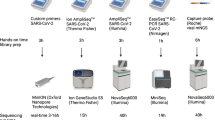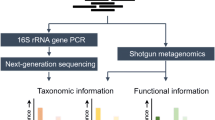Abstract
Porcine reproductive and respiratory syndrome virus (PRRSV) causes significant animal morbidity and mortality and economic losses worldwide. In this study, we analyzed the microbiota in bronchoalveolar lavage fluid (BAL), mucosa, and feces in cecum of the PRRSV-challenged pigs using the Illumina MiSeq sequencing platform, to investigate the role of microbiota in the pathogenesis and development of porcine reproductive and respiratory syndrome (PRRS). Quantitative insights into microbial ecology analyses indicated that the dominant bacterial groups in the lung from the PRRSV-challenged pigs were Haemophilus parasuis and Mycoplasma hyorhinis, with a relative abundance of 35–48% and 27–41%, respectively. Our results were consistent with the clinical observation that the PRRSV-infected pigs are always co-infected with other bacteria, such as Haemophilus and Mycoplasma. On the other hand, Campylobacter and Clostridium became the two most abundant bacteria in the mucosal and luminal microbiota of the cecum of the PRRSV-challenged pigs, and the relative abundance was four times higher than that in the healthy pigs. This suggested that Campylobacter and Clostridium might be associated with the pathogenesis of diarrhea in PRRS. Linear discriminant analysis effect size reveals significant microbial dysbiosis of BAL, mucosa, and feces in cecum of the PRRSV-challenged pigs. We have identified a structural imbalance of the microbiota, characterized by a reduced diversity of microbiota and abundance alterations of certain bacteria in the PRRSV-challenged pigs. The observed microbiota dysbiosis in this study provides insight into the roles of the microbiota in the complications of the PRRSV infection.



Similar content being viewed by others

References
Wang Y, Xue J, Zhou X, You M, Du Q, Yang X (2014) Oral microbiota distinguishes acute lymphoblastic leukemia pediatric hosts from healthy populations. PLoS ONE 9:e110449
Niederwerder MC (2017) Role of the microbiome in swine respiratory disease. Vet Microbiol 209:97–106
Hu Y, Wang M, Zhang X, Wang P, Liu H, Wang Q (2016) Heterogeneity of swine lung macrophages inoculated by porcine reproductive and respiratory syndrome virus. Food Agr Immunol 27(5):724–733
Mann E, Schmitz-Esser S, Zebeli Q, Wagner M, Ritzmann M, Metzler-Zebeli BU (2014) Mucosa-associated bacterial microbiome of the gastrointestinal tract of weaned pigs and dynamics linked to dietary calcium-phosphorus. PLoS ONE 9(1):e86950
Sun Y, Xie B, Wang M, Dong C, Du X, Fu Y, Liu H (2016) Microbial community structure and succession of airborne microbes in closed artificial ecosystem. Ecol Eng 88:165–176
Niederwerder MC, Jaing CJ, Thissen JB, Cino-Ozuna AG, Mcloughlin KS, Rowland RR (2016) Microbiome associations in pigs with the best and worst clinical outcomes following co-infection with porcine reproductive and respiratory syndrome virus (prrsv) and porcine circovirus type 2 (pcv2). Vet Microbiol 188:1–11
Jin H, Wan Y, Zhou R, Li L, Luo R, Zhang S, Hu J, Langford PR, Chen H (2008) Identification of genes transcribed by Haemophilus parasuis in necrotic porcine lung through the selective capture of transcribed sequences (scots). Environ Microbiol 10(12):3326–3336
Luehrs A, Siegenthaler S, Grutzner N, Grosse Beilage E, Kuhnert P, Nathues H (2017) Occurrence of Mycoplasma hyorhinis infections in fattening pigs and association with clinical signs and pathological lesions of enzootic pneumonia. Vet Microbiol 203:1–5
Lee JA, Oh YR, Hwang MA, Lee JB, Park SY, Song CS, Choi IS, Lee SW (2016) Mycoplasma hyorhinis is a potential pathogen of porcine respiratory disease complex that aggravates pneumonia caused by porcine reproductive and respiratory syndrome virus. Vet Immunol Immunopathol 177:48–51
Yaeger M, Funk N, Hoffman L (2002) A survey of agents associated with neonatal diarrhea in iowa swine including Clostridium difficile and porcine reproductive and respiratory syndrome virus. J Vet Diagn Invest 14(4):281–287
Ruiz VL, Bersano JG, Carvalho AF, Catroxo MH, Chiebao DP, Gregori F, Miyashiro S, Nassar AF, Oliveira TM, Ogata RA, Scarcelli EP, Tonietti PO (2016) Case-control study of pathogens involved in piglet diarrhea. BMC Res Notes 9(22):1–7
Hatanaka N, Shimizu A, Somroop S, Li Y, Asakura M, Nagita A, Prasad Awasthi S, Hinenoya A, Yamasaki S (2017) High prevalence of Campylobacter ureolyticus in stool specimens of children with diarrhea in japan. Jpn J Infect Dis 70(4):455–457
Epps SV, Harvey RB, Hume ME, Phillips TD, Anderson RC, Nisbet DJ (2013) Foodborne Campylobacter: infections, metabolism, pathogenesis and reservoirs. Int J Environ Res Public Health 10(12):6292–6304
Schneeberg A, Neubauer H, Schmoock G, Baier S, Harlizius J, Nienhoff H, Brase K, Zimmermann S, Seyboldt C (2013) Clostridium difficile genotypes in piglet populations in germany. J Clin Microbiol 51(11):3796–3803
Acknowledgements
This study was supported by the National Natural Science Foundation of China under Grant No. 81172777 and the Dalian Science and Technological Project under Grant No. 2014B11NC096.
Author information
Authors and Affiliations
Corresponding author
Ethics declarations
Conflict of interest
The authors declare that they have no conflict of interest.
Ethical Approval
Animals used in this study were euthanized as per the protocols approved by the Institutional Animal Care and Use Committee, Dalian University. Clinical samples (lung, mucosa, and feces) from pigs were collected. The biological agents used in this study were handled as per the Institutional Biosafety Committee, Dalian University. The animal Ethics Committee approval number was DW2017-080.
Additional information
Publisher’s Note
Springer Nature remains neutral with regard to jurisdictional claims in published maps and institutional affiliations.
Rights and permissions
About this article
Cite this article
Jiang, N., Liu, H., Wang, P. et al. Illumina MiSeq Sequencing Investigation of Microbiota in Bronchoalveolar Lavage Fluid and Cecum of the Swine Infected with PRRSV. Curr Microbiol 76, 222–230 (2019). https://doi.org/10.1007/s00284-018-1613-y
Received:
Accepted:
Published:
Issue Date:
DOI: https://doi.org/10.1007/s00284-018-1613-y



